Information Technology's Impact on Business: A Comprehensive Report
VerifiedAdded on 2021/02/20
|15
|3997
|51
Report
AI Summary
This report delves into the multifaceted role of Information Technology (IT) within the context of business operations, with a specific focus on its impact on the success or failure of enterprises, exemplified by the case of TESCO. The report investigates the significance of IT in various aspects of business management, including data storage, transmission, and manipulation. Furthermore, it examines the ethical and social issues that arise in a global business environment, such as compliance, diversity, and decision-making, and how these factors influence organizational conduct. The report also provides a detailed analysis of different network technologies, including mesh, bus, star, ring, and tree topologies, and their practical applications. It concludes by discussing the importance of intranets and the internet within businesses, highlighting their roles in internal communication, data accessibility, and overall management efficiency. The report incorporates a literature review, analysis, and discussion to provide a comprehensive understanding of the subject matter.

Introduction to Information Technology
1
1
Paraphrase This Document
Need a fresh take? Get an instant paraphrase of this document with our AI Paraphraser

ABSTRACT
The report should be explored the Information technology which useful for
telecommunications to store, transmit, retrieve and manipulate the data. It should be considered
the different role of Information technology in the business failure or success. As identified with
the ethical or social issues that pertain for running business across the world. Moreover, it has
used the network topologies for system development to transmit the data from one place to
another by using hardware devices. As summarised the significance of intranet and internet in
the enterprise for management.
2
The report should be explored the Information technology which useful for
telecommunications to store, transmit, retrieve and manipulate the data. It should be considered
the different role of Information technology in the business failure or success. As identified with
the ethical or social issues that pertain for running business across the world. Moreover, it has
used the network topologies for system development to transmit the data from one place to
another by using hardware devices. As summarised the significance of intranet and internet in
the enterprise for management.
2
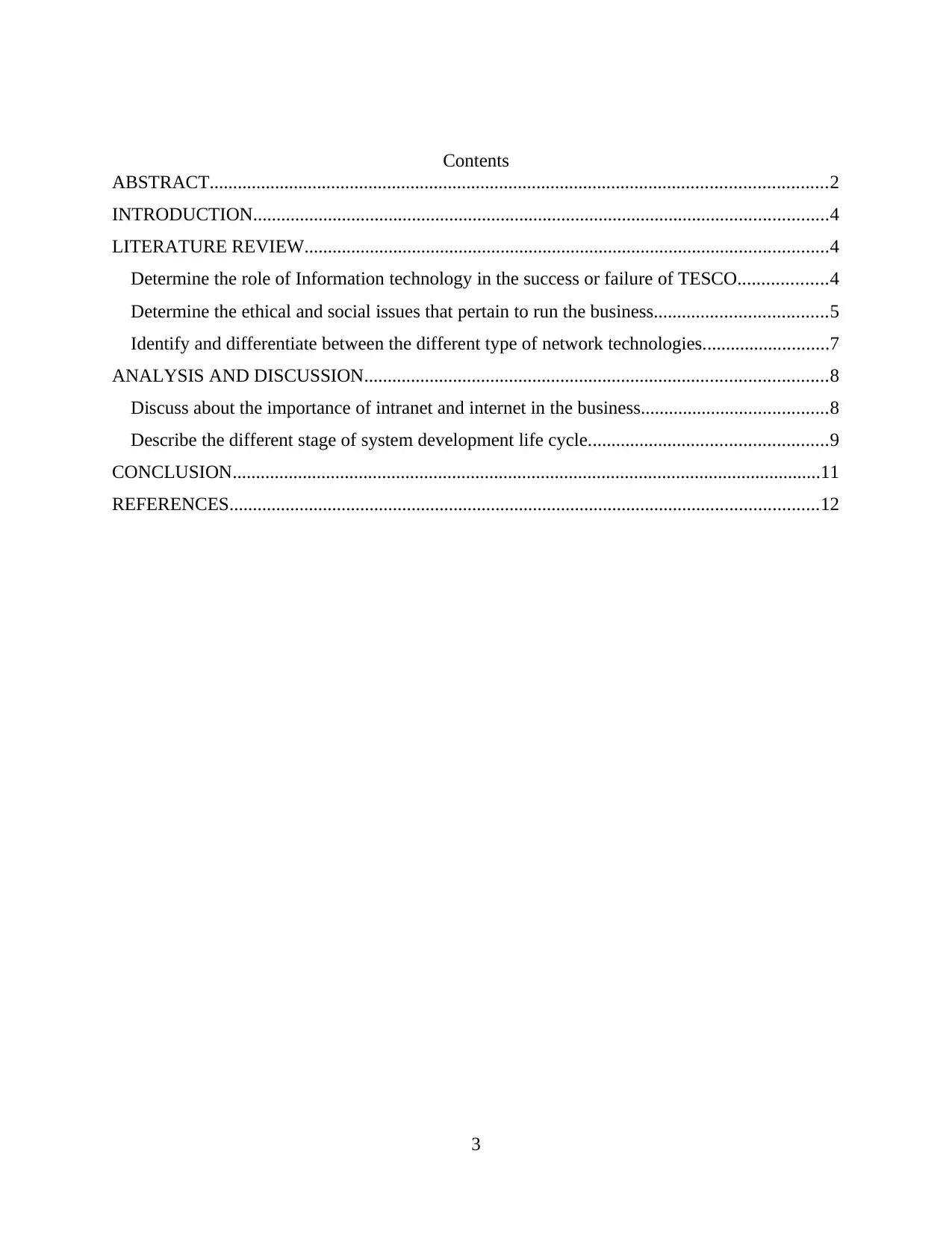
Contents
ABSTRACT....................................................................................................................................2
INTRODUCTION...........................................................................................................................4
LITERATURE REVIEW................................................................................................................4
Determine the role of Information technology in the success or failure of TESCO...................4
Determine the ethical and social issues that pertain to run the business.....................................5
Identify and differentiate between the different type of network technologies...........................7
ANALYSIS AND DISCUSSION...................................................................................................8
Discuss about the importance of intranet and internet in the business........................................8
Describe the different stage of system development life cycle...................................................9
CONCLUSION..............................................................................................................................11
REFERENCES..............................................................................................................................12
3
ABSTRACT....................................................................................................................................2
INTRODUCTION...........................................................................................................................4
LITERATURE REVIEW................................................................................................................4
Determine the role of Information technology in the success or failure of TESCO...................4
Determine the ethical and social issues that pertain to run the business.....................................5
Identify and differentiate between the different type of network technologies...........................7
ANALYSIS AND DISCUSSION...................................................................................................8
Discuss about the importance of intranet and internet in the business........................................8
Describe the different stage of system development life cycle...................................................9
CONCLUSION..............................................................................................................................11
REFERENCES..............................................................................................................................12
3
⊘ This is a preview!⊘
Do you want full access?
Subscribe today to unlock all pages.

Trusted by 1+ million students worldwide
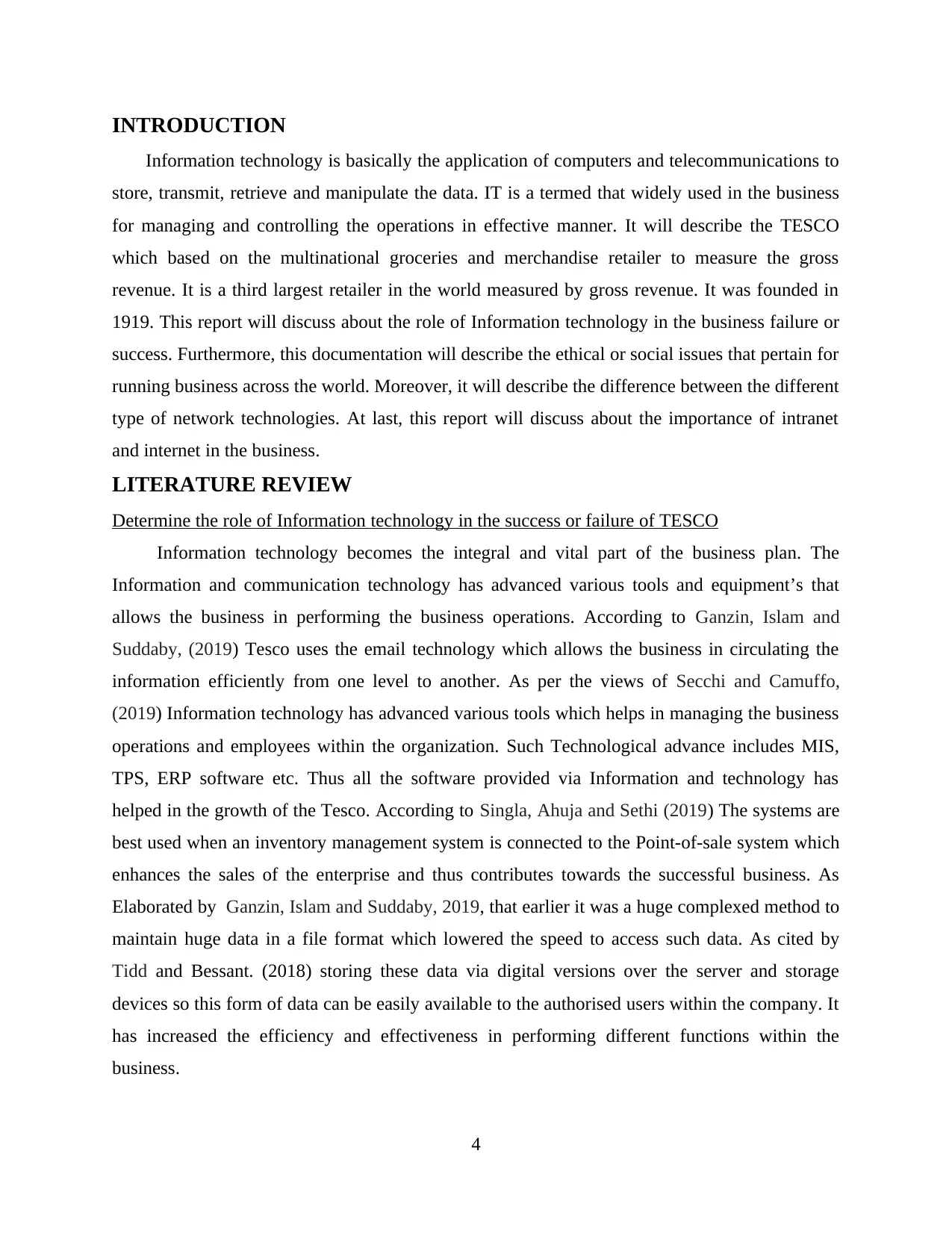
INTRODUCTION
Information technology is basically the application of computers and telecommunications to
store, transmit, retrieve and manipulate the data. IT is a termed that widely used in the business
for managing and controlling the operations in effective manner. It will describe the TESCO
which based on the multinational groceries and merchandise retailer to measure the gross
revenue. It is a third largest retailer in the world measured by gross revenue. It was founded in
1919. This report will discuss about the role of Information technology in the business failure or
success. Furthermore, this documentation will describe the ethical or social issues that pertain for
running business across the world. Moreover, it will describe the difference between the different
type of network technologies. At last, this report will discuss about the importance of intranet
and internet in the business.
LITERATURE REVIEW
Determine the role of Information technology in the success or failure of TESCO
Information technology becomes the integral and vital part of the business plan. The
Information and communication technology has advanced various tools and equipment’s that
allows the business in performing the business operations. According to Ganzin, Islam and
Suddaby, (2019) Tesco uses the email technology which allows the business in circulating the
information efficiently from one level to another. As per the views of Secchi and Camuffo,
(2019) Information technology has advanced various tools which helps in managing the business
operations and employees within the organization. Such Technological advance includes MIS,
TPS, ERP software etc. Thus all the software provided via Information and technology has
helped in the growth of the Tesco. According to Singla, Ahuja and Sethi (2019) The systems are
best used when an inventory management system is connected to the Point-of-sale system which
enhances the sales of the enterprise and thus contributes towards the successful business. As
Elaborated by Ganzin, Islam and Suddaby, 2019, that earlier it was a huge complexed method to
maintain huge data in a file format which lowered the speed to access such data. As cited by
Tidd and Bessant. (2018) storing these data via digital versions over the server and storage
devices so this form of data can be easily available to the authorised users within the company. It
has increased the efficiency and effectiveness in performing different functions within the
business.
4
Information technology is basically the application of computers and telecommunications to
store, transmit, retrieve and manipulate the data. IT is a termed that widely used in the business
for managing and controlling the operations in effective manner. It will describe the TESCO
which based on the multinational groceries and merchandise retailer to measure the gross
revenue. It is a third largest retailer in the world measured by gross revenue. It was founded in
1919. This report will discuss about the role of Information technology in the business failure or
success. Furthermore, this documentation will describe the ethical or social issues that pertain for
running business across the world. Moreover, it will describe the difference between the different
type of network technologies. At last, this report will discuss about the importance of intranet
and internet in the business.
LITERATURE REVIEW
Determine the role of Information technology in the success or failure of TESCO
Information technology becomes the integral and vital part of the business plan. The
Information and communication technology has advanced various tools and equipment’s that
allows the business in performing the business operations. According to Ganzin, Islam and
Suddaby, (2019) Tesco uses the email technology which allows the business in circulating the
information efficiently from one level to another. As per the views of Secchi and Camuffo,
(2019) Information technology has advanced various tools which helps in managing the business
operations and employees within the organization. Such Technological advance includes MIS,
TPS, ERP software etc. Thus all the software provided via Information and technology has
helped in the growth of the Tesco. According to Singla, Ahuja and Sethi (2019) The systems are
best used when an inventory management system is connected to the Point-of-sale system which
enhances the sales of the enterprise and thus contributes towards the successful business. As
Elaborated by Ganzin, Islam and Suddaby, 2019, that earlier it was a huge complexed method to
maintain huge data in a file format which lowered the speed to access such data. As cited by
Tidd and Bessant. (2018) storing these data via digital versions over the server and storage
devices so this form of data can be easily available to the authorised users within the company. It
has increased the efficiency and effectiveness in performing different functions within the
business.
4
Paraphrase This Document
Need a fresh take? Get an instant paraphrase of this document with our AI Paraphraser
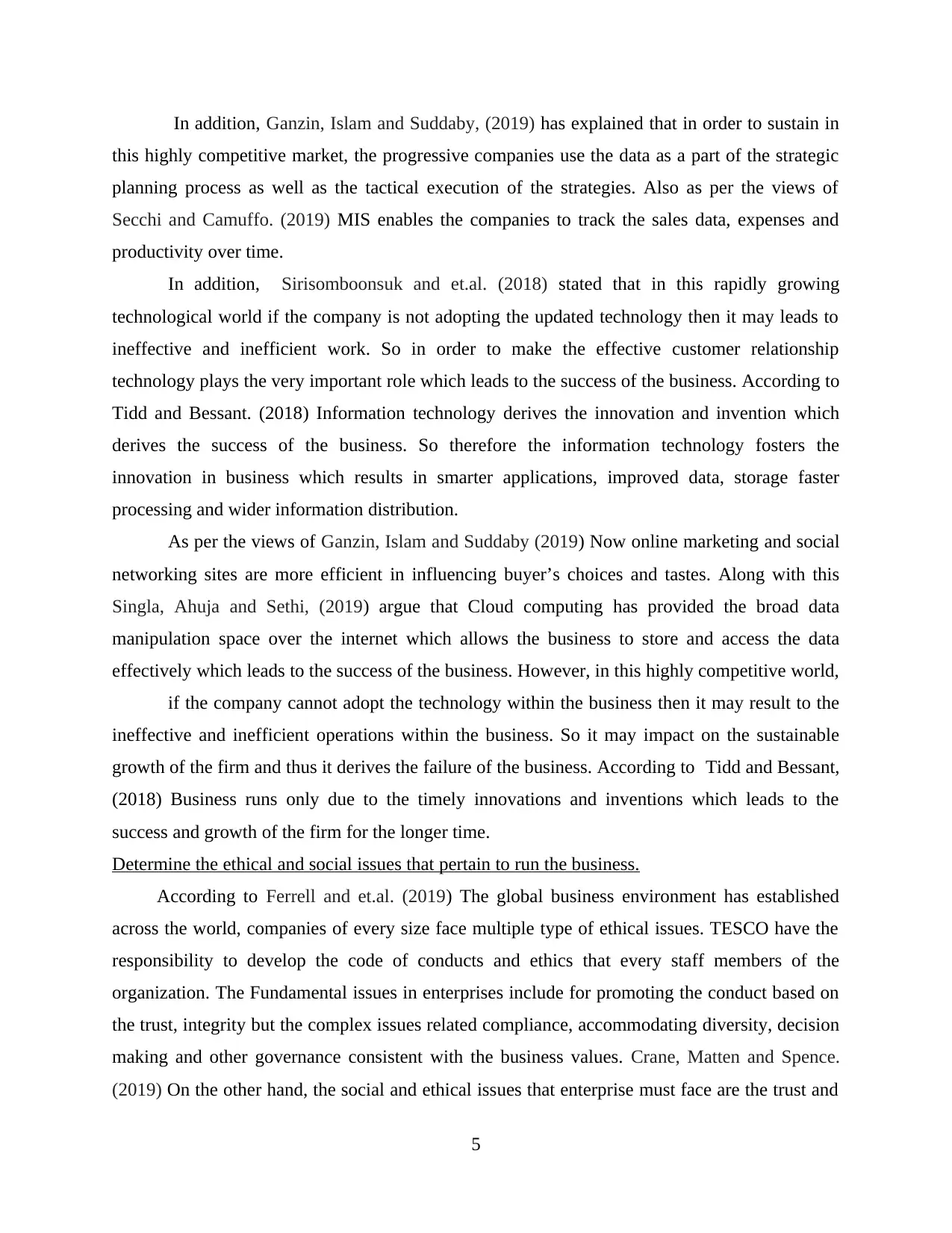
In addition, Ganzin, Islam and Suddaby, (2019) has explained that in order to sustain in
this highly competitive market, the progressive companies use the data as a part of the strategic
planning process as well as the tactical execution of the strategies. Also as per the views of
Secchi and Camuffo. (2019) MIS enables the companies to track the sales data, expenses and
productivity over time.
In addition, Sirisomboonsuk and et.al. (2018) stated that in this rapidly growing
technological world if the company is not adopting the updated technology then it may leads to
ineffective and inefficient work. So in order to make the effective customer relationship
technology plays the very important role which leads to the success of the business. According to
Tidd and Bessant. (2018) Information technology derives the innovation and invention which
derives the success of the business. So therefore the information technology fosters the
innovation in business which results in smarter applications, improved data, storage faster
processing and wider information distribution.
As per the views of Ganzin, Islam and Suddaby (2019) Now online marketing and social
networking sites are more efficient in influencing buyer’s choices and tastes. Along with this
Singla, Ahuja and Sethi, (2019) argue that Cloud computing has provided the broad data
manipulation space over the internet which allows the business to store and access the data
effectively which leads to the success of the business. However, in this highly competitive world,
if the company cannot adopt the technology within the business then it may result to the
ineffective and inefficient operations within the business. So it may impact on the sustainable
growth of the firm and thus it derives the failure of the business. According to Tidd and Bessant,
(2018) Business runs only due to the timely innovations and inventions which leads to the
success and growth of the firm for the longer time.
Determine the ethical and social issues that pertain to run the business.
According to Ferrell and et.al. (2019) The global business environment has established
across the world, companies of every size face multiple type of ethical issues. TESCO have the
responsibility to develop the code of conducts and ethics that every staff members of the
organization. The Fundamental issues in enterprises include for promoting the conduct based on
the trust, integrity but the complex issues related compliance, accommodating diversity, decision
making and other governance consistent with the business values. Crane, Matten and Spence.
(2019) On the other hand, the social and ethical issues that enterprise must face are the trust and
5
this highly competitive market, the progressive companies use the data as a part of the strategic
planning process as well as the tactical execution of the strategies. Also as per the views of
Secchi and Camuffo. (2019) MIS enables the companies to track the sales data, expenses and
productivity over time.
In addition, Sirisomboonsuk and et.al. (2018) stated that in this rapidly growing
technological world if the company is not adopting the updated technology then it may leads to
ineffective and inefficient work. So in order to make the effective customer relationship
technology plays the very important role which leads to the success of the business. According to
Tidd and Bessant. (2018) Information technology derives the innovation and invention which
derives the success of the business. So therefore the information technology fosters the
innovation in business which results in smarter applications, improved data, storage faster
processing and wider information distribution.
As per the views of Ganzin, Islam and Suddaby (2019) Now online marketing and social
networking sites are more efficient in influencing buyer’s choices and tastes. Along with this
Singla, Ahuja and Sethi, (2019) argue that Cloud computing has provided the broad data
manipulation space over the internet which allows the business to store and access the data
effectively which leads to the success of the business. However, in this highly competitive world,
if the company cannot adopt the technology within the business then it may result to the
ineffective and inefficient operations within the business. So it may impact on the sustainable
growth of the firm and thus it derives the failure of the business. According to Tidd and Bessant,
(2018) Business runs only due to the timely innovations and inventions which leads to the
success and growth of the firm for the longer time.
Determine the ethical and social issues that pertain to run the business.
According to Ferrell and et.al. (2019) The global business environment has established
across the world, companies of every size face multiple type of ethical issues. TESCO have the
responsibility to develop the code of conducts and ethics that every staff members of the
organization. The Fundamental issues in enterprises include for promoting the conduct based on
the trust, integrity but the complex issues related compliance, accommodating diversity, decision
making and other governance consistent with the business values. Crane, Matten and Spence.
(2019) On the other hand, the social and ethical issues that enterprise must face are the trust and
5

integrity. It is basic understanding to include the idea of business affair with commitment and
honesty for treating every client fairly.
As per view of Ferguson. (2018) Decision making is a type of ethical issues that explore
the ethical dilemmas for identifying the action such as gathering facts, making a right decision,
evaluating the alternative actions etc. Ethical decision making method should be helping the
employee to protect and secure the equal rights. It makes sure all enterprise operation performs
are fair and just protecting the common good.
According to Perrault and Quinn. (2018) Compliance and Governance issues in the
TESCO that are expected to fully comply with the environment laws, state safety regulations and
other fiscal reporting statues. It is compliances to ensure the company that may ask for employee
to break law and against the value of company procedures and policies. Tesco can manage the
ethics at workplace by establishing and ethics management programs to handle the corporate
values by using codes or policies.
According to Fortis and et.al. (2018) Playing Favorite is normal for leaders to hire the
efficient employee from its social network. It is a type of ethical issues at workplace because
social connection is very important that help to maintain good relationship between employees at
workplace. Favoritism are despised because it is important the employee’s job performance than
the blood relational.
According Schaltegger and Burritt (2018) Business ethics are considered as a main
responsibility at workplace but also within the social structures, environmental and social
responsibilities of community. The corporation must operate the government, guideline and other
local regulations that may through the code of conduct. It was challenging for enterprise to
balance the ethics and moral values in business culture or environment. On the other hand, the
discrimination of sexual, racial and wages in equality are main ethical issues that effect on both
employer and employees. It is required for employer to provide the equal opportunities of their
employees so that they can aware about the legislation and equal rights. It is important for every
enterprise to use the proper rules and regulation to maintain the ethical or moral issues at
workplace environment.
6
honesty for treating every client fairly.
As per view of Ferguson. (2018) Decision making is a type of ethical issues that explore
the ethical dilemmas for identifying the action such as gathering facts, making a right decision,
evaluating the alternative actions etc. Ethical decision making method should be helping the
employee to protect and secure the equal rights. It makes sure all enterprise operation performs
are fair and just protecting the common good.
According to Perrault and Quinn. (2018) Compliance and Governance issues in the
TESCO that are expected to fully comply with the environment laws, state safety regulations and
other fiscal reporting statues. It is compliances to ensure the company that may ask for employee
to break law and against the value of company procedures and policies. Tesco can manage the
ethics at workplace by establishing and ethics management programs to handle the corporate
values by using codes or policies.
According to Fortis and et.al. (2018) Playing Favorite is normal for leaders to hire the
efficient employee from its social network. It is a type of ethical issues at workplace because
social connection is very important that help to maintain good relationship between employees at
workplace. Favoritism are despised because it is important the employee’s job performance than
the blood relational.
According Schaltegger and Burritt (2018) Business ethics are considered as a main
responsibility at workplace but also within the social structures, environmental and social
responsibilities of community. The corporation must operate the government, guideline and other
local regulations that may through the code of conduct. It was challenging for enterprise to
balance the ethics and moral values in business culture or environment. On the other hand, the
discrimination of sexual, racial and wages in equality are main ethical issues that effect on both
employer and employees. It is required for employer to provide the equal opportunities of their
employees so that they can aware about the legislation and equal rights. It is important for every
enterprise to use the proper rules and regulation to maintain the ethical or moral issues at
workplace environment.
6
⊘ This is a preview!⊘
Do you want full access?
Subscribe today to unlock all pages.

Trusted by 1+ million students worldwide
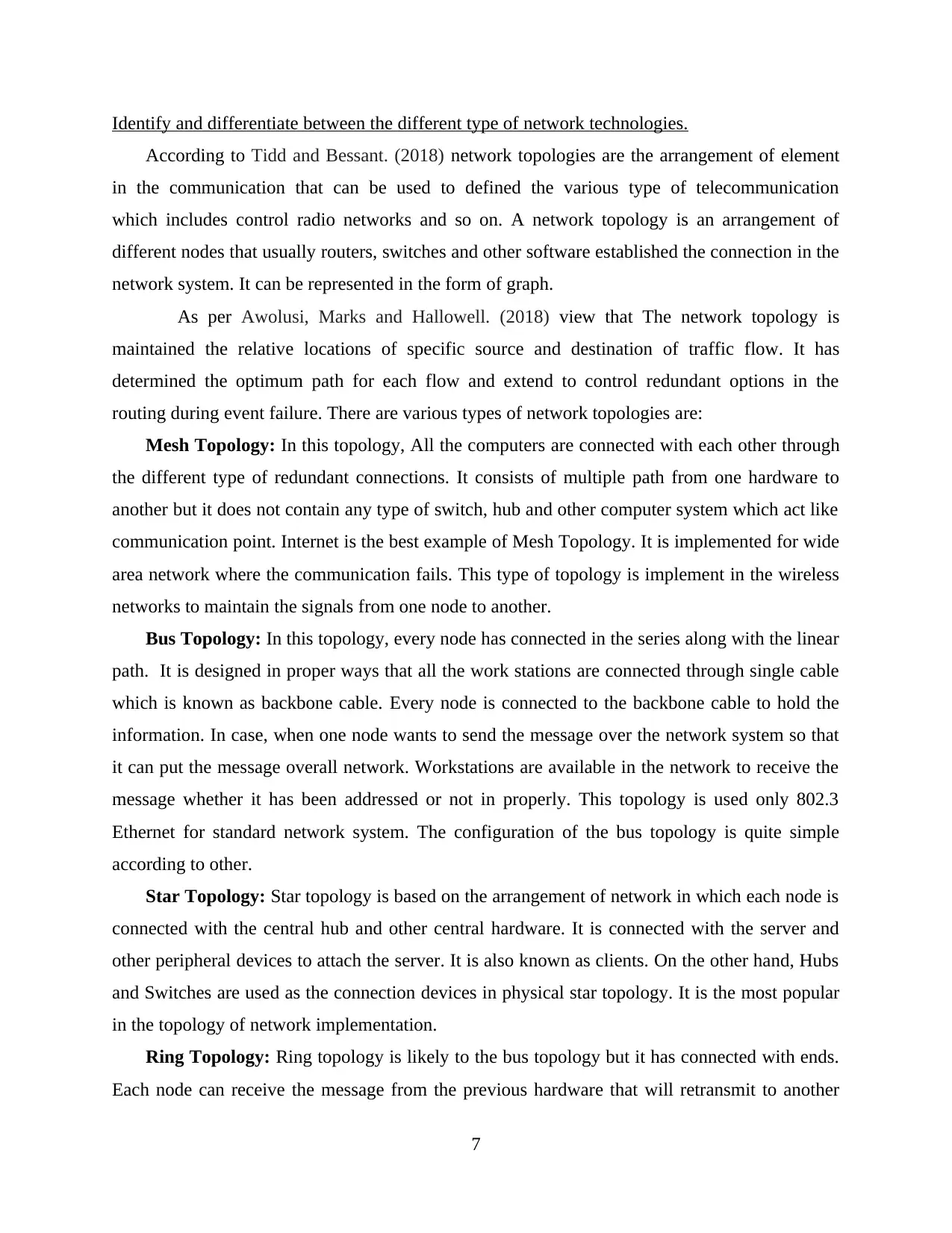
Identify and differentiate between the different type of network technologies.
According to Tidd and Bessant. (2018) network topologies are the arrangement of element
in the communication that can be used to defined the various type of telecommunication
which includes control radio networks and so on. A network topology is an arrangement of
different nodes that usually routers, switches and other software established the connection in the
network system. It can be represented in the form of graph.
As per Awolusi, Marks and Hallowell. (2018) view that The network topology is
maintained the relative locations of specific source and destination of traffic flow. It has
determined the optimum path for each flow and extend to control redundant options in the
routing during event failure. There are various types of network topologies are:
Mesh Topology: In this topology, All the computers are connected with each other through
the different type of redundant connections. It consists of multiple path from one hardware to
another but it does not contain any type of switch, hub and other computer system which act like
communication point. Internet is the best example of Mesh Topology. It is implemented for wide
area network where the communication fails. This type of topology is implement in the wireless
networks to maintain the signals from one node to another.
Bus Topology: In this topology, every node has connected in the series along with the linear
path. It is designed in proper ways that all the work stations are connected through single cable
which is known as backbone cable. Every node is connected to the backbone cable to hold the
information. In case, when one node wants to send the message over the network system so that
it can put the message overall network. Workstations are available in the network to receive the
message whether it has been addressed or not in properly. This topology is used only 802.3
Ethernet for standard network system. The configuration of the bus topology is quite simple
according to other.
Star Topology: Star topology is based on the arrangement of network in which each node is
connected with the central hub and other central hardware. It is connected with the server and
other peripheral devices to attach the server. It is also known as clients. On the other hand, Hubs
and Switches are used as the connection devices in physical star topology. It is the most popular
in the topology of network implementation.
Ring Topology: Ring topology is likely to the bus topology but it has connected with ends.
Each node can receive the message from the previous hardware that will retransmit to another
7
According to Tidd and Bessant. (2018) network topologies are the arrangement of element
in the communication that can be used to defined the various type of telecommunication
which includes control radio networks and so on. A network topology is an arrangement of
different nodes that usually routers, switches and other software established the connection in the
network system. It can be represented in the form of graph.
As per Awolusi, Marks and Hallowell. (2018) view that The network topology is
maintained the relative locations of specific source and destination of traffic flow. It has
determined the optimum path for each flow and extend to control redundant options in the
routing during event failure. There are various types of network topologies are:
Mesh Topology: In this topology, All the computers are connected with each other through
the different type of redundant connections. It consists of multiple path from one hardware to
another but it does not contain any type of switch, hub and other computer system which act like
communication point. Internet is the best example of Mesh Topology. It is implemented for wide
area network where the communication fails. This type of topology is implement in the wireless
networks to maintain the signals from one node to another.
Bus Topology: In this topology, every node has connected in the series along with the linear
path. It is designed in proper ways that all the work stations are connected through single cable
which is known as backbone cable. Every node is connected to the backbone cable to hold the
information. In case, when one node wants to send the message over the network system so that
it can put the message overall network. Workstations are available in the network to receive the
message whether it has been addressed or not in properly. This topology is used only 802.3
Ethernet for standard network system. The configuration of the bus topology is quite simple
according to other.
Star Topology: Star topology is based on the arrangement of network in which each node is
connected with the central hub and other central hardware. It is connected with the server and
other peripheral devices to attach the server. It is also known as clients. On the other hand, Hubs
and Switches are used as the connection devices in physical star topology. It is the most popular
in the topology of network implementation.
Ring Topology: Ring topology is likely to the bus topology but it has connected with ends.
Each node can receive the message from the previous hardware that will retransmit to another
7
Paraphrase This Document
Need a fresh take? Get an instant paraphrase of this document with our AI Paraphraser
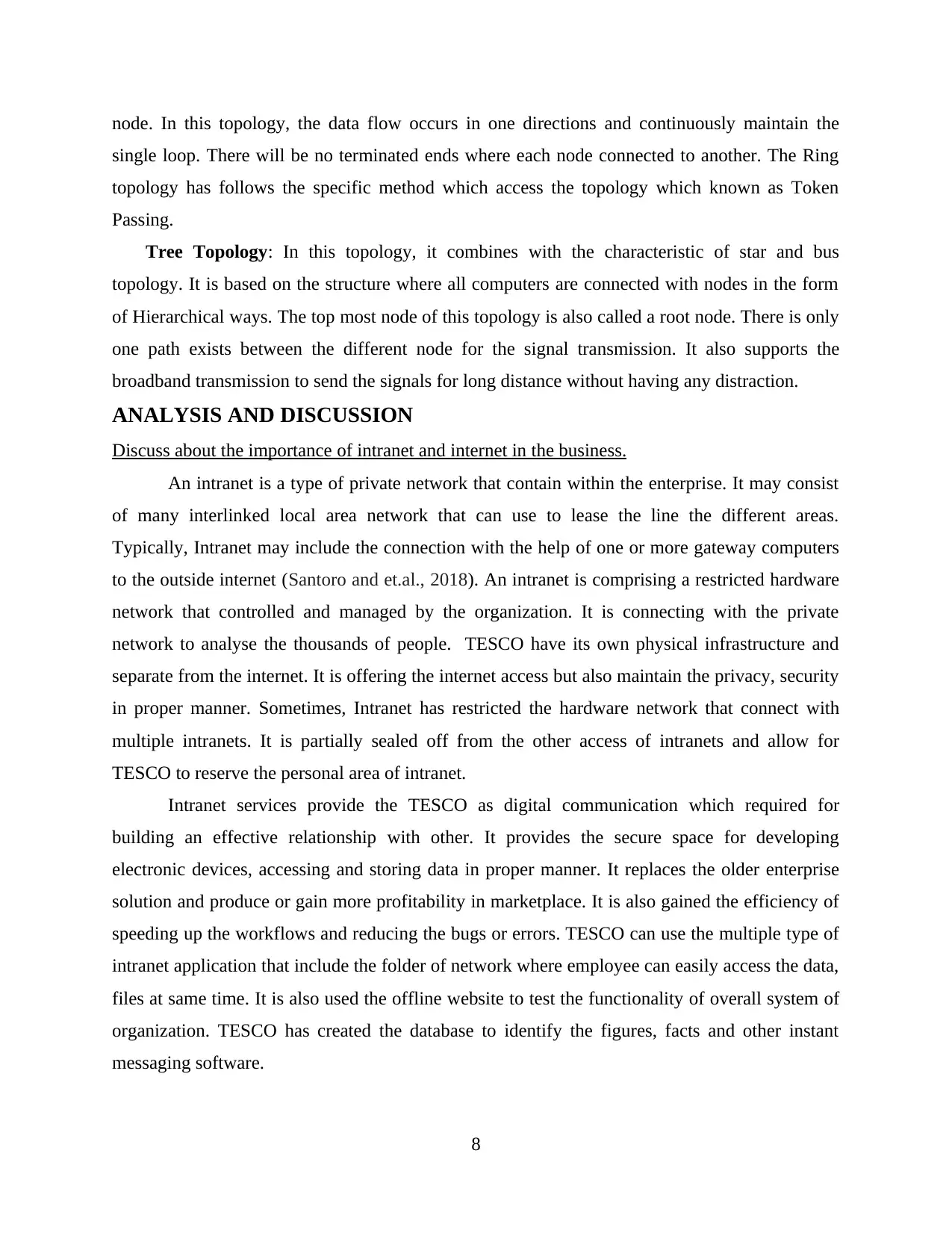
node. In this topology, the data flow occurs in one directions and continuously maintain the
single loop. There will be no terminated ends where each node connected to another. The Ring
topology has follows the specific method which access the topology which known as Token
Passing.
Tree Topology: In this topology, it combines with the characteristic of star and bus
topology. It is based on the structure where all computers are connected with nodes in the form
of Hierarchical ways. The top most node of this topology is also called a root node. There is only
one path exists between the different node for the signal transmission. It also supports the
broadband transmission to send the signals for long distance without having any distraction.
ANALYSIS AND DISCUSSION
Discuss about the importance of intranet and internet in the business.
An intranet is a type of private network that contain within the enterprise. It may consist
of many interlinked local area network that can use to lease the line the different areas.
Typically, Intranet may include the connection with the help of one or more gateway computers
to the outside internet (Santoro and et.al., 2018). An intranet is comprising a restricted hardware
network that controlled and managed by the organization. It is connecting with the private
network to analyse the thousands of people. TESCO have its own physical infrastructure and
separate from the internet. It is offering the internet access but also maintain the privacy, security
in proper manner. Sometimes, Intranet has restricted the hardware network that connect with
multiple intranets. It is partially sealed off from the other access of intranets and allow for
TESCO to reserve the personal area of intranet.
Intranet services provide the TESCO as digital communication which required for
building an effective relationship with other. It provides the secure space for developing
electronic devices, accessing and storing data in proper manner. It replaces the older enterprise
solution and produce or gain more profitability in marketplace. It is also gained the efficiency of
speeding up the workflows and reducing the bugs or errors. TESCO can use the multiple type of
intranet application that include the folder of network where employee can easily access the data,
files at same time. It is also used the offline website to test the functionality of overall system of
organization. TESCO has created the database to identify the figures, facts and other instant
messaging software.
8
single loop. There will be no terminated ends where each node connected to another. The Ring
topology has follows the specific method which access the topology which known as Token
Passing.
Tree Topology: In this topology, it combines with the characteristic of star and bus
topology. It is based on the structure where all computers are connected with nodes in the form
of Hierarchical ways. The top most node of this topology is also called a root node. There is only
one path exists between the different node for the signal transmission. It also supports the
broadband transmission to send the signals for long distance without having any distraction.
ANALYSIS AND DISCUSSION
Discuss about the importance of intranet and internet in the business.
An intranet is a type of private network that contain within the enterprise. It may consist
of many interlinked local area network that can use to lease the line the different areas.
Typically, Intranet may include the connection with the help of one or more gateway computers
to the outside internet (Santoro and et.al., 2018). An intranet is comprising a restricted hardware
network that controlled and managed by the organization. It is connecting with the private
network to analyse the thousands of people. TESCO have its own physical infrastructure and
separate from the internet. It is offering the internet access but also maintain the privacy, security
in proper manner. Sometimes, Intranet has restricted the hardware network that connect with
multiple intranets. It is partially sealed off from the other access of intranets and allow for
TESCO to reserve the personal area of intranet.
Intranet services provide the TESCO as digital communication which required for
building an effective relationship with other. It provides the secure space for developing
electronic devices, accessing and storing data in proper manner. It replaces the older enterprise
solution and produce or gain more profitability in marketplace. It is also gained the efficiency of
speeding up the workflows and reducing the bugs or errors. TESCO can use the multiple type of
intranet application that include the folder of network where employee can easily access the data,
files at same time. It is also used the offline website to test the functionality of overall system of
organization. TESCO has created the database to identify the figures, facts and other instant
messaging software.
8
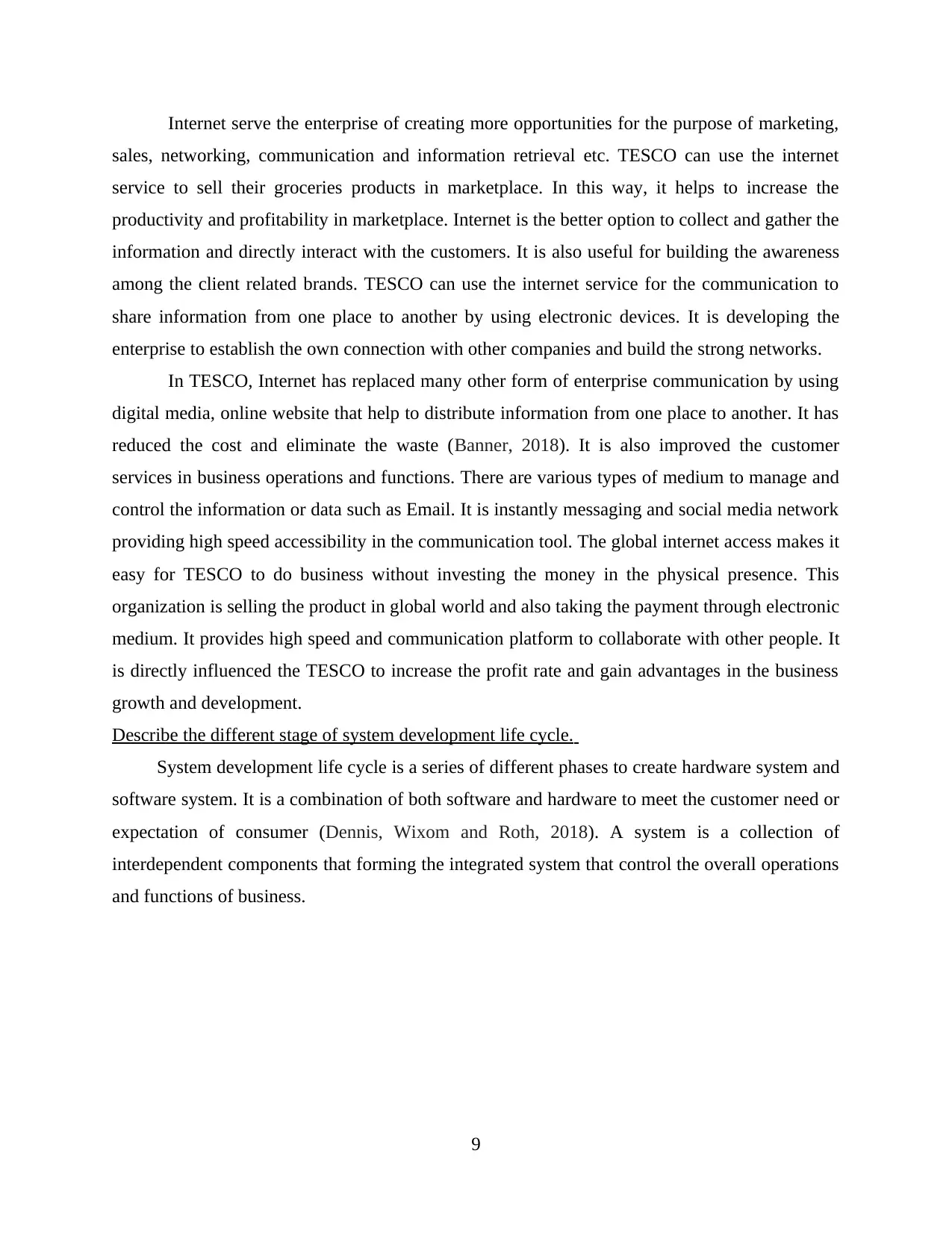
Internet serve the enterprise of creating more opportunities for the purpose of marketing,
sales, networking, communication and information retrieval etc. TESCO can use the internet
service to sell their groceries products in marketplace. In this way, it helps to increase the
productivity and profitability in marketplace. Internet is the better option to collect and gather the
information and directly interact with the customers. It is also useful for building the awareness
among the client related brands. TESCO can use the internet service for the communication to
share information from one place to another by using electronic devices. It is developing the
enterprise to establish the own connection with other companies and build the strong networks.
In TESCO, Internet has replaced many other form of enterprise communication by using
digital media, online website that help to distribute information from one place to another. It has
reduced the cost and eliminate the waste (Banner, 2018). It is also improved the customer
services in business operations and functions. There are various types of medium to manage and
control the information or data such as Email. It is instantly messaging and social media network
providing high speed accessibility in the communication tool. The global internet access makes it
easy for TESCO to do business without investing the money in the physical presence. This
organization is selling the product in global world and also taking the payment through electronic
medium. It provides high speed and communication platform to collaborate with other people. It
is directly influenced the TESCO to increase the profit rate and gain advantages in the business
growth and development.
Describe the different stage of system development life cycle.
System development life cycle is a series of different phases to create hardware system and
software system. It is a combination of both software and hardware to meet the customer need or
expectation of consumer (Dennis, Wixom and Roth, 2018). A system is a collection of
interdependent components that forming the integrated system that control the overall operations
and functions of business.
9
sales, networking, communication and information retrieval etc. TESCO can use the internet
service to sell their groceries products in marketplace. In this way, it helps to increase the
productivity and profitability in marketplace. Internet is the better option to collect and gather the
information and directly interact with the customers. It is also useful for building the awareness
among the client related brands. TESCO can use the internet service for the communication to
share information from one place to another by using electronic devices. It is developing the
enterprise to establish the own connection with other companies and build the strong networks.
In TESCO, Internet has replaced many other form of enterprise communication by using
digital media, online website that help to distribute information from one place to another. It has
reduced the cost and eliminate the waste (Banner, 2018). It is also improved the customer
services in business operations and functions. There are various types of medium to manage and
control the information or data such as Email. It is instantly messaging and social media network
providing high speed accessibility in the communication tool. The global internet access makes it
easy for TESCO to do business without investing the money in the physical presence. This
organization is selling the product in global world and also taking the payment through electronic
medium. It provides high speed and communication platform to collaborate with other people. It
is directly influenced the TESCO to increase the profit rate and gain advantages in the business
growth and development.
Describe the different stage of system development life cycle.
System development life cycle is a series of different phases to create hardware system and
software system. It is a combination of both software and hardware to meet the customer need or
expectation of consumer (Dennis, Wixom and Roth, 2018). A system is a collection of
interdependent components that forming the integrated system that control the overall operations
and functions of business.
9
⊘ This is a preview!⊘
Do you want full access?
Subscribe today to unlock all pages.

Trusted by 1+ million students worldwide
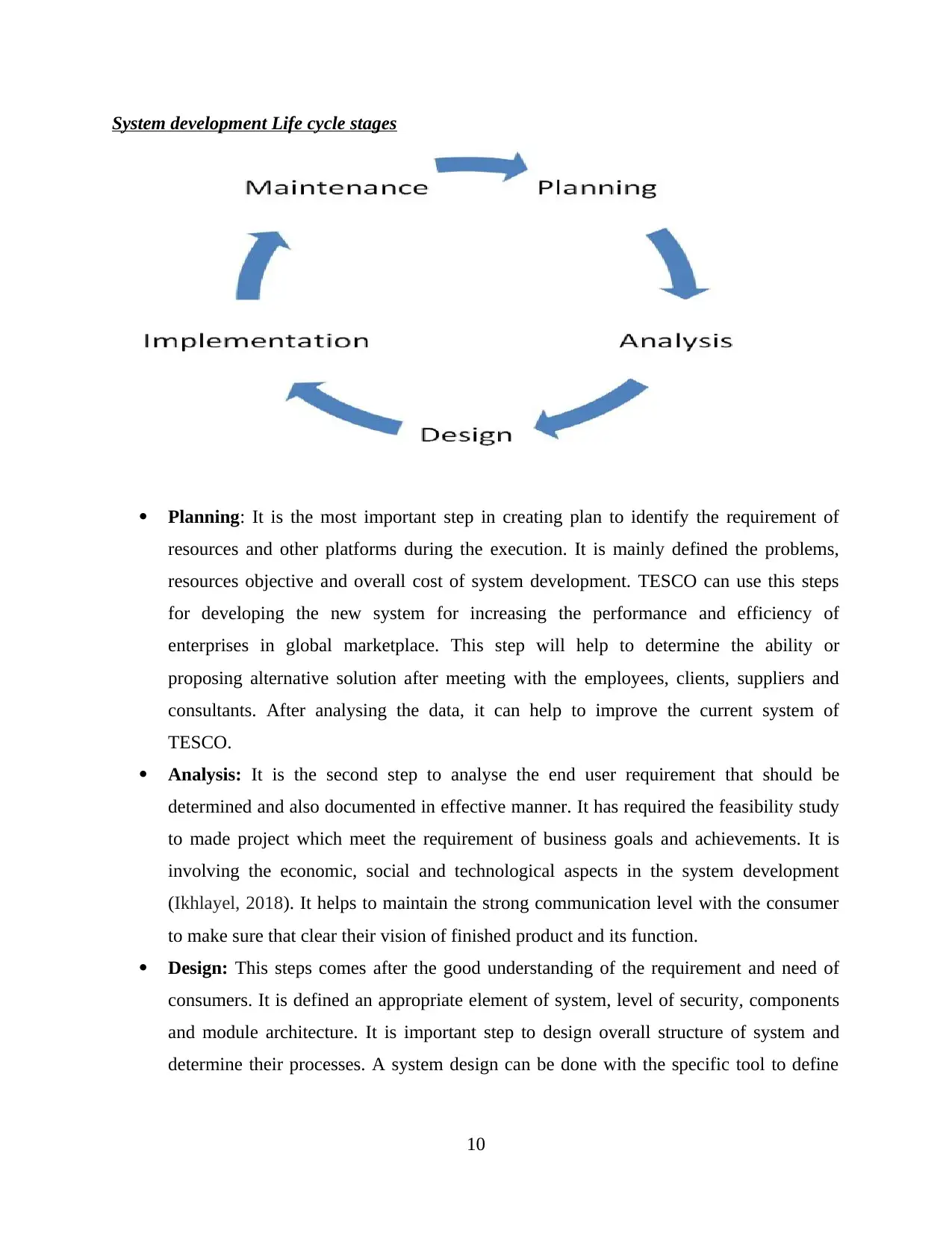
System development Life cycle stages
Planning: It is the most important step in creating plan to identify the requirement of
resources and other platforms during the execution. It is mainly defined the problems,
resources objective and overall cost of system development. TESCO can use this steps
for developing the new system for increasing the performance and efficiency of
enterprises in global marketplace. This step will help to determine the ability or
proposing alternative solution after meeting with the employees, clients, suppliers and
consultants. After analysing the data, it can help to improve the current system of
TESCO.
Analysis: It is the second step to analyse the end user requirement that should be
determined and also documented in effective manner. It has required the feasibility study
to made project which meet the requirement of business goals and achievements. It is
involving the economic, social and technological aspects in the system development
(Ikhlayel, 2018). It helps to maintain the strong communication level with the consumer
to make sure that clear their vision of finished product and its function.
Design: This steps comes after the good understanding of the requirement and need of
consumers. It is defined an appropriate element of system, level of security, components
and module architecture. It is important step to design overall structure of system and
determine their processes. A system design can be done with the specific tool to define
10
Planning: It is the most important step in creating plan to identify the requirement of
resources and other platforms during the execution. It is mainly defined the problems,
resources objective and overall cost of system development. TESCO can use this steps
for developing the new system for increasing the performance and efficiency of
enterprises in global marketplace. This step will help to determine the ability or
proposing alternative solution after meeting with the employees, clients, suppliers and
consultants. After analysing the data, it can help to improve the current system of
TESCO.
Analysis: It is the second step to analyse the end user requirement that should be
determined and also documented in effective manner. It has required the feasibility study
to made project which meet the requirement of business goals and achievements. It is
involving the economic, social and technological aspects in the system development
(Ikhlayel, 2018). It helps to maintain the strong communication level with the consumer
to make sure that clear their vision of finished product and its function.
Design: This steps comes after the good understanding of the requirement and need of
consumers. It is defined an appropriate element of system, level of security, components
and module architecture. It is important step to design overall structure of system and
determine their processes. A system design can be done with the specific tool to define
10
Paraphrase This Document
Need a fresh take? Get an instant paraphrase of this document with our AI Paraphraser
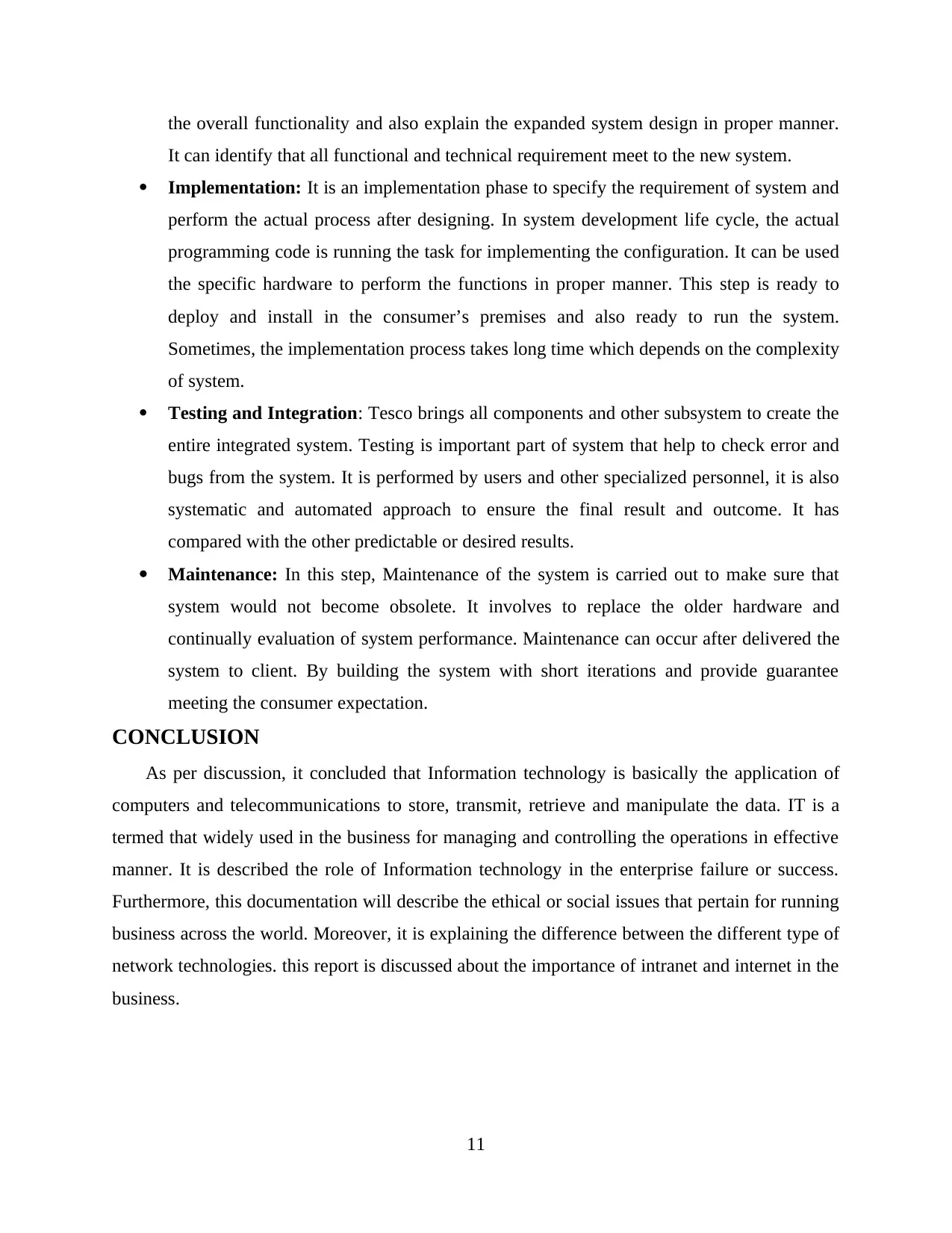
the overall functionality and also explain the expanded system design in proper manner.
It can identify that all functional and technical requirement meet to the new system.
Implementation: It is an implementation phase to specify the requirement of system and
perform the actual process after designing. In system development life cycle, the actual
programming code is running the task for implementing the configuration. It can be used
the specific hardware to perform the functions in proper manner. This step is ready to
deploy and install in the consumer’s premises and also ready to run the system.
Sometimes, the implementation process takes long time which depends on the complexity
of system.
Testing and Integration: Tesco brings all components and other subsystem to create the
entire integrated system. Testing is important part of system that help to check error and
bugs from the system. It is performed by users and other specialized personnel, it is also
systematic and automated approach to ensure the final result and outcome. It has
compared with the other predictable or desired results.
Maintenance: In this step, Maintenance of the system is carried out to make sure that
system would not become obsolete. It involves to replace the older hardware and
continually evaluation of system performance. Maintenance can occur after delivered the
system to client. By building the system with short iterations and provide guarantee
meeting the consumer expectation.
CONCLUSION
As per discussion, it concluded that Information technology is basically the application of
computers and telecommunications to store, transmit, retrieve and manipulate the data. IT is a
termed that widely used in the business for managing and controlling the operations in effective
manner. It is described the role of Information technology in the enterprise failure or success.
Furthermore, this documentation will describe the ethical or social issues that pertain for running
business across the world. Moreover, it is explaining the difference between the different type of
network technologies. this report is discussed about the importance of intranet and internet in the
business.
11
It can identify that all functional and technical requirement meet to the new system.
Implementation: It is an implementation phase to specify the requirement of system and
perform the actual process after designing. In system development life cycle, the actual
programming code is running the task for implementing the configuration. It can be used
the specific hardware to perform the functions in proper manner. This step is ready to
deploy and install in the consumer’s premises and also ready to run the system.
Sometimes, the implementation process takes long time which depends on the complexity
of system.
Testing and Integration: Tesco brings all components and other subsystem to create the
entire integrated system. Testing is important part of system that help to check error and
bugs from the system. It is performed by users and other specialized personnel, it is also
systematic and automated approach to ensure the final result and outcome. It has
compared with the other predictable or desired results.
Maintenance: In this step, Maintenance of the system is carried out to make sure that
system would not become obsolete. It involves to replace the older hardware and
continually evaluation of system performance. Maintenance can occur after delivered the
system to client. By building the system with short iterations and provide guarantee
meeting the consumer expectation.
CONCLUSION
As per discussion, it concluded that Information technology is basically the application of
computers and telecommunications to store, transmit, retrieve and manipulate the data. IT is a
termed that widely used in the business for managing and controlling the operations in effective
manner. It is described the role of Information technology in the enterprise failure or success.
Furthermore, this documentation will describe the ethical or social issues that pertain for running
business across the world. Moreover, it is explaining the difference between the different type of
network technologies. this report is discussed about the importance of intranet and internet in the
business.
11
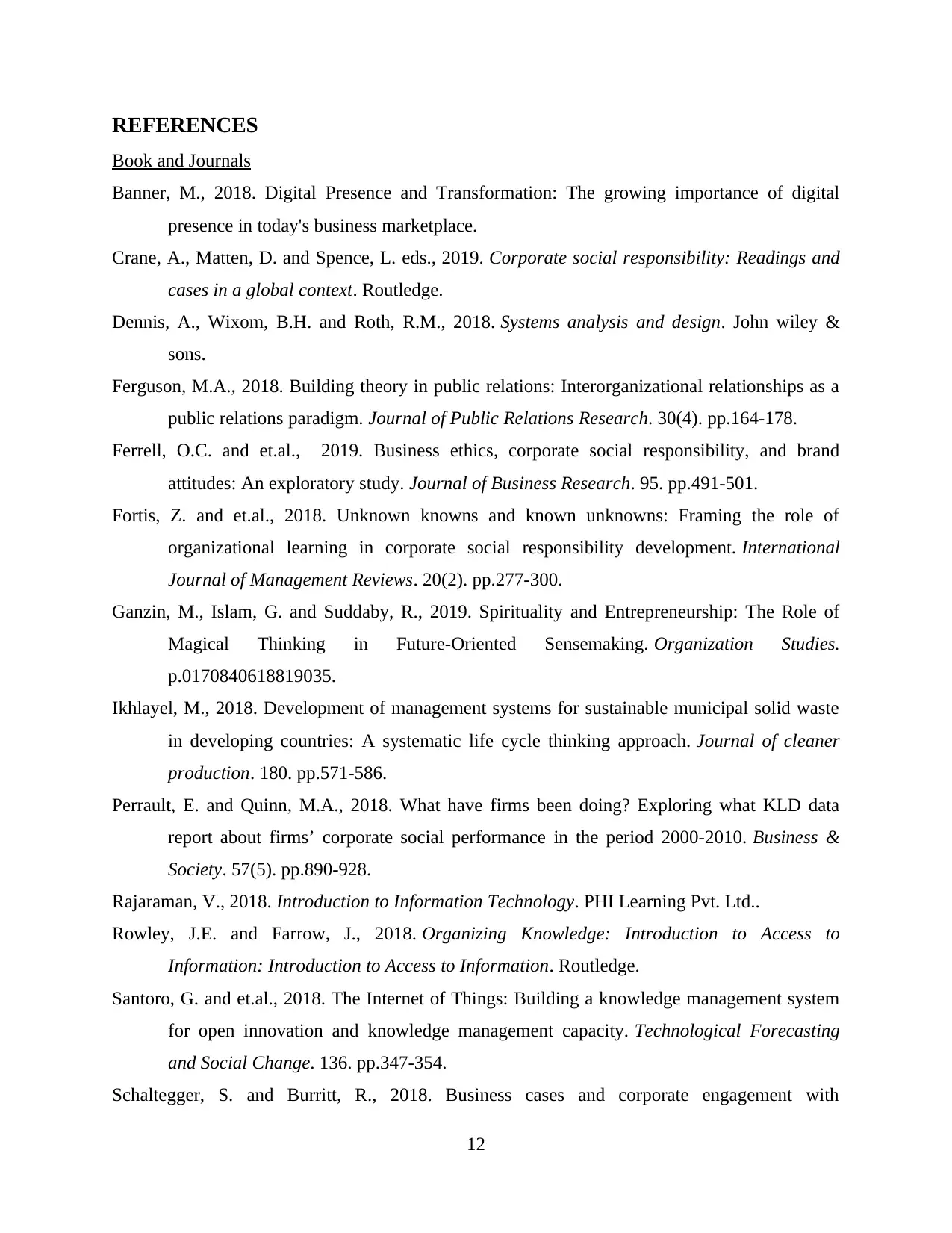
REFERENCES
Book and Journals
Banner, M., 2018. Digital Presence and Transformation: The growing importance of digital
presence in today's business marketplace.
Crane, A., Matten, D. and Spence, L. eds., 2019. Corporate social responsibility: Readings and
cases in a global context. Routledge.
Dennis, A., Wixom, B.H. and Roth, R.M., 2018. Systems analysis and design. John wiley &
sons.
Ferguson, M.A., 2018. Building theory in public relations: Interorganizational relationships as a
public relations paradigm. Journal of Public Relations Research. 30(4). pp.164-178.
Ferrell, O.C. and et.al., 2019. Business ethics, corporate social responsibility, and brand
attitudes: An exploratory study. Journal of Business Research. 95. pp.491-501.
Fortis, Z. and et.al., 2018. Unknown knowns and known unknowns: Framing the role of
organizational learning in corporate social responsibility development. International
Journal of Management Reviews. 20(2). pp.277-300.
Ganzin, M., Islam, G. and Suddaby, R., 2019. Spirituality and Entrepreneurship: The Role of
Magical Thinking in Future-Oriented Sensemaking. Organization Studies.
p.0170840618819035.
Ikhlayel, M., 2018. Development of management systems for sustainable municipal solid waste
in developing countries: A systematic life cycle thinking approach. Journal of cleaner
production. 180. pp.571-586.
Perrault, E. and Quinn, M.A., 2018. What have firms been doing? Exploring what KLD data
report about firms’ corporate social performance in the period 2000-2010. Business &
Society. 57(5). pp.890-928.
Rajaraman, V., 2018. Introduction to Information Technology. PHI Learning Pvt. Ltd..
Rowley, J.E. and Farrow, J., 2018. Organizing Knowledge: Introduction to Access to
Information: Introduction to Access to Information. Routledge.
Santoro, G. and et.al., 2018. The Internet of Things: Building a knowledge management system
for open innovation and knowledge management capacity. Technological Forecasting
and Social Change. 136. pp.347-354.
Schaltegger, S. and Burritt, R., 2018. Business cases and corporate engagement with
12
Book and Journals
Banner, M., 2018. Digital Presence and Transformation: The growing importance of digital
presence in today's business marketplace.
Crane, A., Matten, D. and Spence, L. eds., 2019. Corporate social responsibility: Readings and
cases in a global context. Routledge.
Dennis, A., Wixom, B.H. and Roth, R.M., 2018. Systems analysis and design. John wiley &
sons.
Ferguson, M.A., 2018. Building theory in public relations: Interorganizational relationships as a
public relations paradigm. Journal of Public Relations Research. 30(4). pp.164-178.
Ferrell, O.C. and et.al., 2019. Business ethics, corporate social responsibility, and brand
attitudes: An exploratory study. Journal of Business Research. 95. pp.491-501.
Fortis, Z. and et.al., 2018. Unknown knowns and known unknowns: Framing the role of
organizational learning in corporate social responsibility development. International
Journal of Management Reviews. 20(2). pp.277-300.
Ganzin, M., Islam, G. and Suddaby, R., 2019. Spirituality and Entrepreneurship: The Role of
Magical Thinking in Future-Oriented Sensemaking. Organization Studies.
p.0170840618819035.
Ikhlayel, M., 2018. Development of management systems for sustainable municipal solid waste
in developing countries: A systematic life cycle thinking approach. Journal of cleaner
production. 180. pp.571-586.
Perrault, E. and Quinn, M.A., 2018. What have firms been doing? Exploring what KLD data
report about firms’ corporate social performance in the period 2000-2010. Business &
Society. 57(5). pp.890-928.
Rajaraman, V., 2018. Introduction to Information Technology. PHI Learning Pvt. Ltd..
Rowley, J.E. and Farrow, J., 2018. Organizing Knowledge: Introduction to Access to
Information: Introduction to Access to Information. Routledge.
Santoro, G. and et.al., 2018. The Internet of Things: Building a knowledge management system
for open innovation and knowledge management capacity. Technological Forecasting
and Social Change. 136. pp.347-354.
Schaltegger, S. and Burritt, R., 2018. Business cases and corporate engagement with
12
⊘ This is a preview!⊘
Do you want full access?
Subscribe today to unlock all pages.

Trusted by 1+ million students worldwide
1 out of 15
Related Documents
Your All-in-One AI-Powered Toolkit for Academic Success.
+13062052269
info@desklib.com
Available 24*7 on WhatsApp / Email
![[object Object]](/_next/static/media/star-bottom.7253800d.svg)
Unlock your academic potential
Copyright © 2020–2025 A2Z Services. All Rights Reserved. Developed and managed by ZUCOL.





